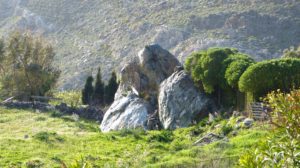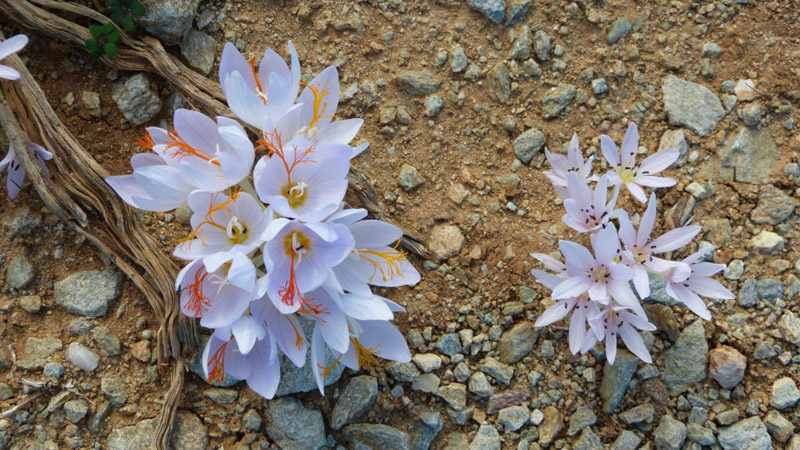by Achilles Dimitropoulos
There are two points of view related to the woodland character of the Cyclades through time. According to the first one these islands were always barren with very limited vegetation. Their landscape has changed very little with the passage of time.
The second view suggests that these islands were green and forested many years ago, attributing the cause of their present barren face to lumbering, wildfires and various other environmental factors. The more we search the past of the islands the more we discover indications that lead to the conclusion that in past times there was indeed thicker vegetation, and even isolated forests, but the real picture of the islands was far from the “paradise” that the “romantic” second view claims. It is indeed possible, that the distribution of the vegetation zones and biotopes was like the present day one. The coastal woodlands and swamps were the more vulnerable biotopes and the first ones to be degraded and, later, lost. On the contrary, the vegetation around the scarce water sources of the mainland was preserved relatively intact and in some of the Cyclades there are still preserved parts of ancient forests which surround the few wetlands hidden in the mountain slopes and the deep valleys.
For the researcher in the field of zoogeography, it is certain that most of the animal species existing today on the islands have existed since old times and either they increased in number, if the environmental changes were favorable, or they decreased due to human activities and the degradation of their habitats. It is natural that the more ecologically specializing species were more vulnerable and decreased in numbers, with some reaching the point of extinction, than those closer to man or the more adaptable ones. The carnivores, like the wild cat and the large birds of prey are a characteristic example. On the contrary, reptiles expanded together with the phrygana – type vegetation that replaced certain lumbered or burnt woodlands.

The flora of Syros is characterized by Mediterranean species of bushes and phrygana, which in some cases are attaining tree form. The commonest of these “trees” is always the Areftià or Fὶda which is no other than the two species of Juniper (Juniperus phoenicea καιJ. macrocarpa). In times past, these bushes were very widespread and most probably, they formed impenetrable thickets; these were the ones that Della Rocca referred to, when he wrote that the Turks and the Venetians had destroyed the costal woodlands of the island situated opposite Delos, i.e. Syros.
Phoenician Juniper had many uses for the inhabitants of the island: Its wood is hard, and it is known that the Turks made sword handles with it. As fuel, it gives a bright flame and was used in kilns of iron and copper smithies, after it was made into coal (blacksmith-coal).
Contrarily to Tournefort who claims that timber on the island is scarce, Ambelas and Della Rocca insist that there was in “enough abundance”. Apart of two species of Juniper, on the island there exist moreover, wickers, wild olive trees and carobs. Carobs together with wild goat meat consisted the main food of the about 400 “Syriots” when Buondelmonti met them in 1414.
Since very old times, there have been many systematic “reforestations” with pine trees in various places of Syros, as on the Anastasis hill and the slopes of the Vaporia district. Tamarisks were planted (Tamarix sp.)in the saline grounds along the coast from Tarsanas to Axos, as well as on the Vari’s beach and elsewhere.
Other tall bushes used for their wood include also the Holly Oak (Quercus coccifera),the Strawberry Tree (Arbutus unedo),the Italian or Mediterranean Buckthorn (Ramnus alaternus)and the Evergreen Oak. Of the phrygana, the Myrtle and the Laurel as well as the Spanish Broom (Spartium junceum), the Perforate Saint John’s Wort (Hypericum perforatum), the Common Sage(Salvia officinalis), the Gorse(Ulex europaeus), the Thorny Broom (Genista acanthoclada), the Alifonas (Centauria spinosa), and the Common Thyme (Coridothymus capitatus), which together with Spurge (Euphorbia antiquorum)and the Thorny Broom (Genista acanthoclada)were also collected for various domestic uses, from making brooms to the preparation of herbal teas.
The collection of Saffron (Crocus) on Mytakas was a habitual occupation of the inhabitants of Syros. On the island we meet three species of Crocus, Crocus laevigatus, Crocus cartwrightianus, and Crocus tournefortii. In the herbarium of Goulandris Museum of Natural History there are preserved samples of Crocus tournefortiicollected from the Source of Aghios Athanasios, around Aghios Dimitrios site and from Megas Gyalos.
The various place names preserved till today, show the importance that plants had for the inhabitants of the island, not only as objects of their daily lives but also as reference points and place names: Schinonisi (Schinos’ island), Kyperousa (from Cypress Tree), Charoupia (Carob Tree), Ambela (Vineyard), Xylokopi (Timberland),Prasonisi (Leek island), Megalefki (Great Poplar).
The smaller or larger oak forests of the Quercus cocciferaand the Evergreen or Holly Oak Quercus ilex, which probably lived together with clusters or even groves of pine trees (Turkish Pine, Pinus brutiaand, perhaps, Aleppo Pine, Pinus halepensis), as it is shown even today by what is left of the forests of Kea, were of the biotopes that were lost and had comprised an important habitat of the island. The destruction of these forests happened very early in Syros, leaving almost no traces of their existence. On the contrary, today there is no actual forest, or any forest species on the island, and their place is taken by phrygana expanding even on the fallow fields while the erosion renders bare the rocky substrate, which can be seen here and there.
The Mediterranean maquis shrub (3) remains only in some places and becomes thicker in the wet areas, especially near seasonal streams and ravines, which are precious elements from an ecological point of view, as they direct the rain water flow while the bushes hold the soil and prevent erosion. Unfortunately, in other Cyclades’ islands, a regular building on stream beds has begun in the name of the ill-conceived touristic development. Syros is luckier as the few small wetlands in the Source, Syriggas, Piskopio, Chroussa still exist, and they must be protected at any cost.
The plant species that exist on Syros and the Cyclades are few, compared to those of mainland Greece, while many species that exist, for example, in Evia they are completely absent, as already since 1950 Rechinger had observed.
Especially the plants that belong to the phrygana type (4) have irregular distribution. Many species that existed once, today have disappeared. The small number of individuals and the impossibility of their natural re-introduction (from the nearby islands or from Evia) were the main factors that lead to their extinction. Indeed, even the narrow sea straits of 10-20 km are proven that have acted as efficient barriers in the distribution of plants from island to island in the Cyclades. On the other hand, many colonies of specific species which appear to be naturally born are proven to be the direct or indirect results of human intervention.
Other species of plants develop in puddles that fill with water during winter or early in the spring and dry up later. The coastal flora presents great interest, especially that around the more extensive beaches of Agathopes, Vari, Azolimnos, and Kini. Among the rare species that grow there is the exquisite Sea Daffodil (Pancratium maritimum),which is very common on the Agathopes beach and elsewhere.
Rare plants also exist in the wet areas around the Galissas bay, from the water edge up to the paved road; it is certain that there they are threatened by parceling and the touristic development that these last years has made Galissas full of hotels, pubs and restaurants. This area was, certainly, one of the most important biotopes of the island and still today is a stopover for the migrating birds. In August 1988, I, personally, observed several Herons sitting on the cisterns on the peak of the tourist period.
Phyto-geographically, the Cyclades are discerned in groups that have either common characteristics or great differences among them. Many species are found only in one island (Andros is a typical example) or a group of islands, while others have a uniform distribution. Species with uniform distribution are:
- Callicotome villosa – Spiny Broom
- Coridothymus capitatus – Conehead Thyme
- Genista acanthoclada – Broom
- Sarcopoterium spinosum – Thorny Burnet
- Satureia thymbra – Winter Savory
- Carlina corymbosa – Clustered Carline Thistle
- Oryzopsis caerulescens – Perennial or Rice Grass
- Iris sisyrinchium – Barbary Nut
- Astragalus hamosus – European Milkvetch
- Bupleurum gracile –
A schematic classification of the islands according to their phyto-geographic identity was attempted by the scientists of the University of Lund (Sweden) who continue the work of Rechinger since 1957. In this classifictation Sifnos and Syros constitute a phyto-geographic unit. Andros, Tinos and Myconos have more similarities among themselves and with Naxos.
- The author means the extant, present day species, not those which lived in other geological periods.
- A few oaks also exist – apart from Kea – on Andros, Naxos and Ios, while on Gyaros there were pine reforestations.
- Vegetation type of the Mediterranean areas, characterized by bushy plants of various heights and a few trees.
- Vegetation type, characteristic of the Greek islands, but also of areas in the mainland, characterized by the absence of trees while the vegetation has been over browsed and is limited to small low bushes.
- The common variety of plants which bloom in Spring at the edge of the port area from Tarsanas till Lazaretta. Previously there, there were wetlands. These plant species do not exist anywhere else on Syros.
GREEKLITERATURE
- Αμπελά, Τιμ. 1874. lστορία της νήσου Σύρου. Αθήναι.
- Γρύσπου, Π. 1968. Η Δασική Φυσιογνωμία των Κυκλάδων Νήσων. Αθήναι.
- Διαπούλη, Χ. 1961. Ενδημικά Φυτά των Κυκλάδων. Αθήναι.
- Ζερλέντη, Κ. 1952. Συμβολή στη φυτογεωγραφία των Κυκλάδων(διδακτορική διατριβή). Αθήναι.
FOREIGN LITERATURE
- Rechinger,Κ.Η. 1943. Flora Aegaea. Denkschr.Akad.Wiss- Wien. Math.-Νat. ΚΙ. 105( 1).
- Rechinger, Κ.Η. 1949. Florae Aegaea supplementum. Phyton, Ι: 194–228.
- Rechinger, Κ.Η. 1950. Grundzϋge der phlanzenverbreitung in der Αgäis I-III. Vegetatio 2: 55-119, 239-308, 365-386.
- Rechinger, Κ.Η. 1951. Phytogeographia Aegaea. Denkschr. Akad. Wiss. Wien. Math.-Νat. ΚΙ. 105(3).
- Strid, Α. 1970. Studies in the Aegean flora ΧVΙ.Biosystematics of rhe Nigella arvensis complex with special reference in the problem of non – adaptiνe radiation. Opera Botanica 28: 1-169.
- Strid, Α. 1971. Ενοlution in the Aegean. Proceedings of a symposium held at the Department of Plant Taxonomy, Lund, Sweden. Opera Botanica 30.
source: Syros Letters v. 7, 1989.
Translated by Aliki Tsoukala / Edited by Constantine Hatziadoniu

